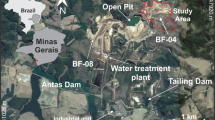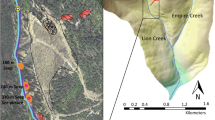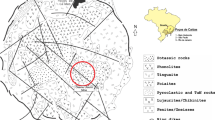Abstract
The Haveri tailings area contains 1.5 Mt of sulfide-bearing waste from the Au–Cu mine that operated during 1942–1961. Geophysical and geochemical methods were used to evaluate and characterize the generation of acid mine drainage (AMD). Correlations were examined among the electrical resistivity tomography (ERT) data, the total sulfide content and concentrations of sulfide-bound metals (Cu, Co, Fe, Mn, Ni, Pb and Zn) of tailings samples, and the resistivity and geochemistry of surface water. The resulting geophysical–geochemical model defines an area in the vadose tailings, where a low resistivity anomaly (<10 Ohm m) is correlated with the highest sulfide content, extensive sulfide oxidation and low pH (average 3.1). The physical and geochemical conditions, resulting from the oxidation of the sulfide minerals, suggest that the low resistivity anomaly is associated with acidic and metal-rich porewater (i.e., AMD). The lower resistivity values in the saturated zone of the central impoundment suggest the formation of a plume of AMD. The natural subsoil layer (silt and clay) and the bedrock surface below the tailings area were well mapped from the ERT data. The detected fracture zones of the bedrock that could work as leakage pathways for AMD were consistent with previous geological studies. The integrated methodology of the study offers a promising approach to fast and reliable monitoring of areas of potential AMD generation and its subsurface movement over large areas (ca. 9 ha). This methodology could be helpful in planning drill core sampling locations for geochemical and mineralogical analysis, groundwater sampling, and choosing and monitoring remedial programs.





Similar content being viewed by others
References
Banks D, Younger PL, Arnesen RT, Iversen ER, Banks SB (1997) Mine-water chemistry: the good, the bad and the ugly. Environ Geol 32(3):157–174
Blowes DW, Reardon EJ, Jambor JL, Cherry JA (1991) The formation and potential importance of cemented layers in inactive sulfide mine tailings. Geochim Cosmochim Acta 55:965–978
Blowes DW, Ptacek CJ, Jambor JL, Weisener, CG (2004) The geochemistry of acid mine drainage. In: Sherwood Lollar B (ed) Treatise on geochemistry–environmental geochemistry, vol 9, pp 149–204
Bobachev AA (1994) IPI2Win software: http://geophys.geol.msu.ru/rec_labe.htlm
Bobachev AA (2003) X2IPI software: http://geophys.geol.msu.ru/x2ipi/x2ipi.htlm
Brookfield AE, Blowes DW, Mayer KU (2006) Integration of field measurements and reactive transport modeling to evaluate contaminant transport at a sulfide mine tailings impoundment. J Contam Hydrol 88:1–22
Buselli G, Lu K (2001) Groundwater contamination monitoring with multichannel electrical and electromagnetic methods. J Appl Geophys 48:11–23
Campbell DL, Fitterman DV (2000) Geoelectrical methods for investigating mine dumps. In: Proceedings from the fifth international conference on acid rock drainage, ICARD 2000, Littleton CO. Society for Mining, Metallurgy and Exploration, Inc., pp 1513–1523
Campbell DL, Horton RJ (2001) Spectral-induced polarization studies of mine waste piles in Colorado and New Mexico. In: Proceedings of the symposium for the application of geophysics to environmental and engineering problems, SAGEEP 2001. Environmental and Engineering Geophysical Society, pp 1–11
Campbell DL, Fitterman DV, Hein AS, Jones DP (1998) Spectral induced polarization studies of mine dumps near Silverton, Colorado. In: Proceedings of the symposium for the application of geophysics to environmental and engineering problems, SAGEEP 1998. Environmental and Engineering Geophysical Society, pp 761–769
Chouteau M, Poisson J, Aubertin M, Campos D (2005) Internal structure and preferential flow of a waste rock pile from geophysical surveys. In: Proceedings of the symposium for the application of geophysics to environmental and engineering problems, SAGEEP 2005. Environmental and Engineering Geophysical Society, pp 289–297
Ebraheem MW, Bayless ER, Krothe NC (1990) A study of acid mine drainage using earth resistivity measurements. Ground Water 28:361–368
Forss M (2006) Structurell tolkning av lineament i flygbilder—Haveriområdet, Tammerfors skifferbälte. Master thesis, Åbo Akademi University, Institutionen för geologi och mineralogi (in Swedish), p 71
Graupner T, Kassahun A, Rammlmair D, Meima JA, Kock D, Furche M, Fiege A, Schippers A, Melcher F (2007) Formation of sequences of cemented layers and hardpans within sulfide-bearing mine tailings (mine district Freiberg, Germany). Appl Geochem 22:2486–2508
Guérin R, Bégassat P, Benderitter Y, David J, Tabagh A, Thiry M (2004) Geophysical study of the industrial waste land in Mortagne-du-Nord (France) using electrical resistivity. Near Surf Geophys 3:137–143
Lin Z (1997) Mobilization and retention of heavy metals in mill-tailings from Garpenberg sulfide mines, Sweden. Sci Total Environ 198:13–31
Loke MH, Barker RD (1996) Rapid least squares inversion of apparent resistivity pseudosections by a quasi-Newton method. Geophys Prospect 44:131–152
Mäkelä K (1980) Geochemistry and origin of Haveri and Kiipu, Proterozoic strata-bound volcanogenic gold-copper and zinc mineralizations from southwestern Finland. Bull Geol Surv Finl 310:17–39
Martín-Crespo T, De Ignacio-San José C, Gómez-Ortiz D, Martín-Velázquez S, Lillo-Ramos J (2010) Monitoring study of the mine pond reclamation of Mina Concepción, Iberian Pyrite Belt (Spain). Environ Earth Sci 59:1275–1284
Martínez-Pagán P, Faz-Cano A, Aracil E, Arocena JM (2009) Electrical resistivity imaging revealed the spatial properties of mine tailing ponds in the Sierra Minera of southeast Spain. J Environ Eng Geophys 14:63–76
McGregor RG, Blowes DW (2002) The physical, chemical and mineralogical properties of three cemented layers within sulfide-bearing mine tailings. J Geochem Explor 76:195–207
Moncur MC, Ptacek CJ, Blowes DW, Jambor JL (2005) Release, transport and attenuation of metals from an old tailings impoundment. Appl Geochem 20:639–659
Nironen M (1994) Structural control and (re) mobilization of the extinct Haveri Au-Cu deposit, southern Finland. Bull Geol Soc Finl 66(1):39–44
Painter MA, Laberty B, Stoertz MW, Green DH (2000) Resistivity imaging of a partially reclaimed coal tailings pile. In: Proceedings of the symposium for the application of geophysics to environmental and engineering problems, SAGEEP 2000. Environmental and Engineering Geophysical Society, pp 1–11
Palacki CJ (1987) Resistivity characteristics of geological targets. In: Nabighian MN (ed) Electromagnetic methods in applied geophysics, vol 1—Theory SEG, Investigation in Geophysics 3:53–129
Parviainen A (2009) Tailings mineralogy and geochemistry at the abandoned Haveri Au–Cu mine, SW Finland. Mine Water Environ 28(4):291–304
Poisson J, Chouteau M, Aubertin M, Campos D (2009) Geophysical experiments to image the shallow internal structure and the moisture distribution of a mine waste rock pile. J Appl Geophys 67(2):179–192
Puustinen K (2003) Suomen kaivosteollisuus ja mineraalisten raaka-aineiden tuotanto vuosina 1530–2001, historiallinen katsaus erityisesti tuotantolukujen valossa. Mining industry and production of raw materials in Finland during 1530–2001, a historic review in the light of production figures. Geological Survey of Finland, report M 10.1/2003/3, 578 (in Finnish)
Rucker DF, Glaser DR, Osborne T, Maehl WC (2009) Electrical resistivity characterization of a reclaimed gold mine to delineate acid rock drainage pathways. Mine Water Environ 28:146–157
Shemang EM, Laletsang K, Chaoka TR (2003) Geophysical investigation of the effect of acid mine drainage on the soil and groundwater near a mine dump, Selebi-Phikwe Cu-Ni Mine, NE Botswana. In: Proceedings of the symposium for the application of geophysics to environmental and engineering problems, SAGEEP 2003. Environmental and Engineering Geophysical Society, pp 930–937
Sjödahl P, Dahlin T, Johansson S (2005) Using resistivity measurements for dam safety evaluation at Enemossen tailings dam in southern Sweden. Environ Geol 49:267–273
Smith BD, Campbell DL, Wright WG (2001) Using resistivity to map acidic waters at the May Day mine dump, Silverton Colorado. In: Proceedings of the symposium for the application of geophysics to environmental and engineering problems, SAGEEP 2001. Environmental and Engineering Geophysical Society, pp 1–12
Telford WM, Geldart LP, Sheriff RE (1990) Applied geophysics. Cambridge University Press, Cambridge, p 770
Vanhala H, Lahti M (2001) Tests of resistivity and IP methods for mapping mine tailings: results from Hammaslahti, a closed Cu mine in eastern Finland. In: Proceedings of 7th EEGS-ES meeting, Birmingham, England, 2–6 Sept 2001
Vanhala H, Räisänen ML, Suppala I, Huotari T, Valjus T, Lehtimäki J (2005) Geophysical characterizing of tailings impoundment—a case from the closed Hammaslahti Cu–Zn mine, eastern Finland. Geological Survey of Finland, Special paper 38:49–60
Yuval, Oldenburg DW (1996) DC resistivity and IP methods in acidic mine drainage problems: results from the Cooper Cliff mine tailings impoundments. J Appl Geophys 34:187–198
Acknowledgments
The authors would like to thank Janne Kaukolinna (Geoenvironmental Technology Research Group, Helsinki University of Technology) for his valuable assistance in the geophysical field work. We are grateful to Prof. Vladimir Shevnin and Dr. A. A. Bobachev from Moscow State University for providing the IPI2Win and X2IPI software. This study was supported by the National Council on Science and Technology of Mexico (CONACYT) (Placencia-Gómez E) and by the Finnish Graduate School in Geology (Parviainen A), and the experimental work was funded under the RAMAS project of the EU Life ENVIRONMENT program (Risk Assessment and Risk Management Procedure for Arsenic in the Tampere Region).
Author information
Authors and Affiliations
Corresponding author
Rights and permissions
About this article
Cite this article
Placencia-Gómez, E., Parviainen, A., Hokkanen, T. et al. Integrated geophysical and geochemical study on AMD generation at the Haveri Au–Cu mine tailings, SW Finland. Environ Earth Sci 61, 1435–1447 (2010). https://doi.org/10.1007/s12665-010-0459-9
Received:
Accepted:
Published:
Issue Date:
DOI: https://doi.org/10.1007/s12665-010-0459-9




